GPS Engine Board Manual
SR-92 Manual V1.0
SSSSRRRR-92-92-92-92
SIRF STAR ⅢⅢⅢⅢ
V 1.0
Easy to Use Ultra-High Performance
GPS Smart Antenna Module
With Power Control
Made in Taiwan
2008/08/08
service@dagamagps.com
www.dagamagps.com
FREE SERVICE HOT-LINE(FOR MAINLAND):400-820-1322
�
SR-92 Manual V1.0
Contents
Specifications subject to
change without prior notice!
1
Introduction ……….………………………………………………………………..... 1
1.1
1.2
1.3
1.4
1.5
OVERVIEW............................................................................................................ 1
MAIN FEATURES................................................................................................... 1
RECEIVER SPECIFICATIONS...................................................................................2
PROTOCOLS.......................................................................................................... 3
ANTENNA............................................................................................................. 3
2
Hardware Interface ………………………………………………………………..... 4
2.1
2.2
2.3
2.4
2.4.1
2.4.2
2.4.3
2.4.4
MODULE DIMENSION........................................................................................... 4
PIN ASSIGNMENT..................................................................................................4
MODULE PLACEMENT.......................................................................................... 4
POWER SAVING.....................................................................................................5
Power Saving of Trickle Power............................................................................5
Power Saving of Adaptive Trickle Power............................................................ 5
Power Saving of Push To Fix............................................................................... 5
Power Saving of Power Switch............................................................................ 6
3
Software Interface ………………………….......………………………………………7
3.1
3.2
3.3
3.4
3.5
3.6
3.7
3.8
NMEA OUTPUT MESSAGES.................................................................................7
GPGGA - GLOBAL POSITIONING SYSTEM FIX DATA...........................................8
GPGLL - GEOGRAPHIC POSITION - LATITUDE / LONGITUDE............................... 8
GPGSA - GNSS DOP AND ACTIVE SATELLITES..................................................9
GPGSV - GNSS SATELLITES IN VIEW................................................................. 9
GPRMC - RECOMMENDED MINIMUM SPECIFIC GNSS DATA............................ 10
GPVTG - COURSE OVER GROUND AND GROUND SPEED................................... 10
GPZDA - SIRF TIMING MESSAGE..................................................................... 11
Electrical and Environmental Data ……………………………………………...…. 12
Application …………………………………………………………………………..... 13
4
5
1
SR-92 User’s Manual V1.0
�
SR-92 Manual V1.0
1 Introduction
1.1 Overview
SR-92 is a low-power, ultra-high performance, easy to use GPS smart antenna module based on
SiRF’s third generation single chip. Its low power consumption and high performance enables the
adoption of handheld applications. The slim design allows SR-92 to be placed on topside of the
housing to have best GPS signal reception. The 5-pin I/O interface is then connected to the main
board with either connector or wire soldering.
The integrated antenna design helps reduce the RF and EMI issues to minimum. Fast adoption and
high yield production becomes possible.
The power control
It’s
especially useful in cases such as to turn off power as the user just wants to watch a movie and
GPS function is not needed in the PMP case.
to turn on/off power via GPIO control pin.
feature is very convenient
1.2 Main Features
Not only handheld but also any other GPS applications can share the following major features of
SR-92.
� Easy adoption with best performance
� Integrated antenna and EMC protection
� Built-in backup battery allowing hot/warm starts and better performance
� No external component demand, just connect and use.
� Minimum RF and EMI efforts
� Small size of 18 (W) x 21 (L) x 7 (H) (mm) with patch antenna of 18x18x4mm.
� Fully implementation of ultra-high performance SiRF StarⅢ single chip architecture
� High tracking sensitivity of -159dBm
� Low power consumption of 40mA at full tracking
� Hardware power saving control pin allowing power off GPS via GPIO
� SR-92 could be arranged at best reception location inside housing
� Firmware upgradeable for future potential performance enhancements
1
SR-92 User’s Manual V1.0
�
1.3 Receiver Specifications
SR-92 Manual V1.0
Features
Specifications
GPS receiver type
Horizontal Position Accuracy
Velocity Accuracy
Time accuracy
TTFF (Time to First Fix)
(50%, -130dBm, autonomous)
Sensitivity
(Autonomous)
Measurement data output
Max. Altitude
Max. Velocity
SBAS Support
Dynamics
Power consumption
Power supply
Dimension (single side)
Operating temperature
Storage temperature
20 channels, L1 frequency, C/A code
< 2.5m (Autonomous)
< 2.0m (WAAS)
(50% 24hr static, -130dBm)
<0.01 m/s (speed)
<0.01° (heading)
(50%@30m/s)
1µs or less
Hot Start: 1s
Warm Start: 35s
Cold Start: 42s
Tracking: –159dBm
Acquisition: -142dBm
Update time: 1 second
NMEA output protocol: V.3.00
Baud rate: 4800 (default), 9600, 19200, 38400, 57600
bps (8-N-1)
Datum: WGS-84
Default: GGA, GSA, RMC, and GSV
Other options: VTG, GLL, ZDA, or SiRF binary
<18,000 m
<1,852 km/hr
WAAS, EGNOS
<4g
40mA, continuous tracking mode
3.3V
18 (W) x 21 (L) x 7 (H) mm w/ 18x18x4 (mm) patch antenna
-40°C ~ +85°C
-40°C ~ +125°C
2
SR-92 User’s Manual V1.0
�
SR-92 Manual V1.0
1.4 Protocols
Both NMEA and SiRF binary protocols could be supported via serial UART I/O port – RXA/TXA.
The default supported protocol is NMEA protocol.
1. Serial communication channel
i.
ii.
No parity, 8-data bit, 1-stop bit (N-8-1)
User selectable factory set baudrate among 4800, 9600, 19200, 38400, and
57600 (default 4800) bps.
2. NMEA 0183 Version 3.00 ASCII output
i.
ii.
Default GGA (1 sec), GSA (1 sec), GSV (3 sec), RMC (1 sec)
Optional VTG, GLL, ZDA
1.5 Antenna
SR-92 has a built-in patch antenna of dimension 18x18x4mm.
To have the best performance, we suggest tuning the RF antenna together with product’s outside
shell of housing.
3
SR-92 User’s Manual V1.0
�
2 Hardware Interface
2.1 Module Dimension
SR-92 Manual V1.0
The dimension of SR-92 is 18 mm (W) x 21 mm (L) x 7 mm (H)
with a patch antenna of 18x18x4mm.
2.2 Pin Assignment
5-pin Interface
Pin
1
Name
GND
Ground
Function
2
3
4
5
VCC
Power supply of 3.3 ~ 5.5 VDC
TX
RX
PWR_CTRL
Port A serial data output (GPS out); N-8-1, NMEA v3.00 output
Port A serial data input (GPS in); N-8-1, accepts commands from external applications, e.g.
SiRFDemo.
Hardware controlled power saving pin.
If this function is used, it is usually connected to a GPIO pin of a micro-processor.
“Low”: for normal run
“High” or floating: turn off VCC for power saving
Tie it to low if this pin is not used.
4
I/O
Input
Input
Output
Input
Input
2.3 Module Placement
The SR-92 module could be placed on any location of your product’s housing that has best signal
reception. The 5-pin interface is then connected to your motherboard. There are two items that
extrude the bottom PCB plane of SR-92. It may affect the placement of SR-92 into your product’s
housing.
1. The antenna is soldered to SR-92 at the bottom via one soldering point. The soldering
extrudes the bottom PCB plane of SR-92. It is suggested to reserve a hole of j = 2 mm and
depth of 1mm on the under housing.
2. The built-in battery is also soldered to SR-92 at the bottom via two
soldering points. The soldering extrudes the bottom PCB plane of SR-92.
4
SR-92 User’s Manual V1.0
�
SR-92 Manual V1.0
2.4 Power Saving
SR-92 supports various kinds of power saving mechanisms – Trickle Power, Adaptive
Trickle Power, Push To Fix, and power switch. The first three kinds of power saving
mechanisms are implemented in software and the power switch mechanism is
implemented in hardware.
2.4.1 Power Saving of Trickle Power
The trickle power saving mechanism is achieved by switching off and on CPU and RF at a
fixed time interval. The biggest time interval to report a position is 10 seconds. The on and
off ratio is configurable. This feature is useful for applications that need to report position
regularly while power saving is significant. This feature is done by firmware automatically if
this feature is enabled. The standard firmware does not turn on this feature. It could be
customized by request of MOQ.
2.4.2 Power Saving of Adaptive Trickle Power
The adaptive trickle power saving mechanism is basically the same as trickle power saving
mechanism with difference that it would not turn the power off if the signal quality is not
good enough for tracking. Thus, it keeps both benefits of performance and power saving
intelligently. This feature is done by firmware automatically if this feature is enabled. The
standard firmware does not turn on this feature. It could be customized by request of MOQ.
2.4.3
Power Saving of Push To Fix
The Push To Fix power saving mechanism will not report position data until a specified time
interval expires or triggered by external event. Typically, to keep the up to date position
data, it would wake up to collect ephemeris and almanac data every 30 minutes. The time
interval is also configurable. This mechanism is especially useful for applications that need
position data only on demand. This feature is done by firmware automatically if this feature
is enabled. The standard firmware does not turn on this feature. It could be customized by
request of MOQ.
5
SR-92 User’s Manual V1.0
�
SR-92 Manual V1.0
2.4.4
Power Saving of Power Switch
The Power Switch power saving mechanism will turn off not only the CPU and RF but also
the whole engine board. In the mean time, the backup battery will start to power GPS’s
RTC and internal memory for better performance.
The power saving is controlled by the external application via the control pin (PWR_CTRL;
pin 5). The engine board will be on if PWR_CTRL pin is low. It would be off if the pin is high
or floating. The designer has full control of the power supply status of the smart antenna.
The power saving is also more complete. Applications such as PMP navigator may prefer
to stop GPS while it just runs movie watching. There might be similar demand for different
applications. This mechanism is achieved by hardware and external control of pin
PWR_CTRL is required if this mechanism is used. Tie this pin to low if the mechanism is
not used.
6
SR-92 User’s Manual V1.0
�

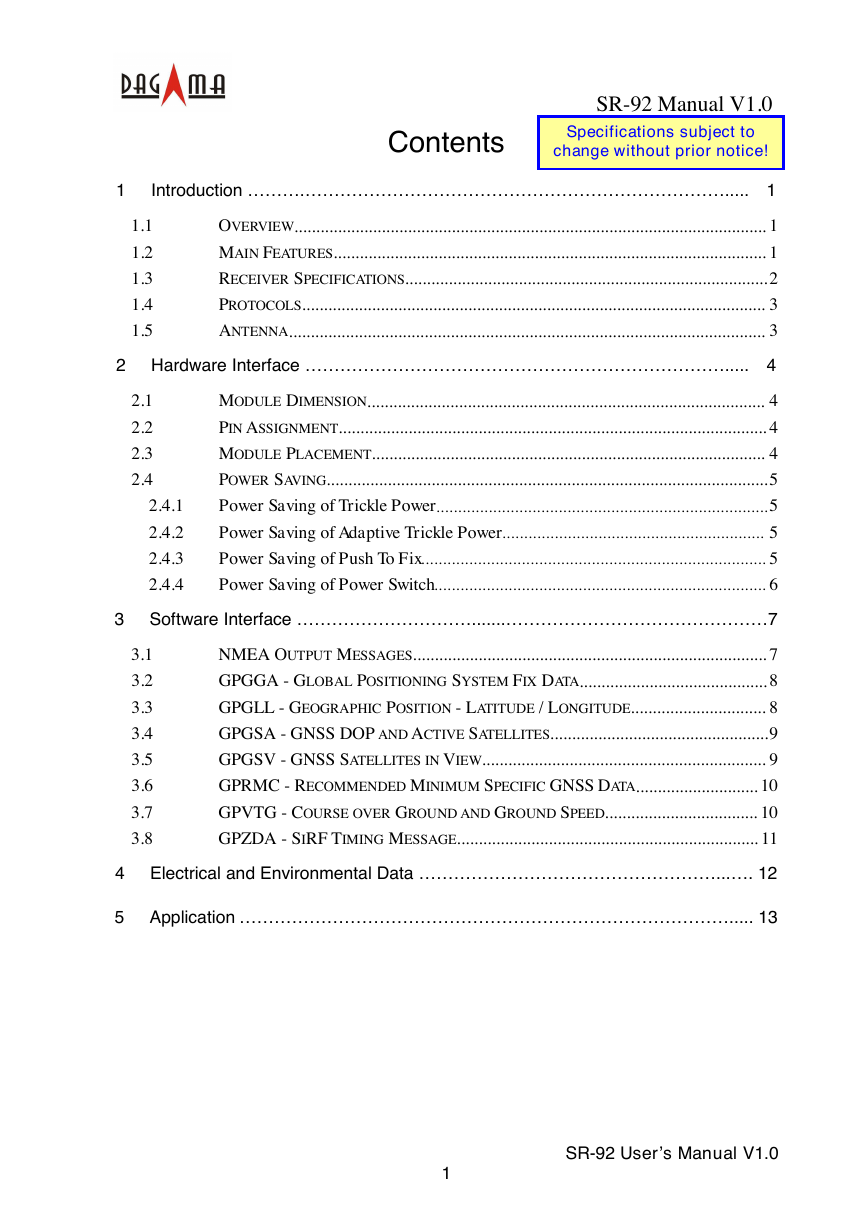
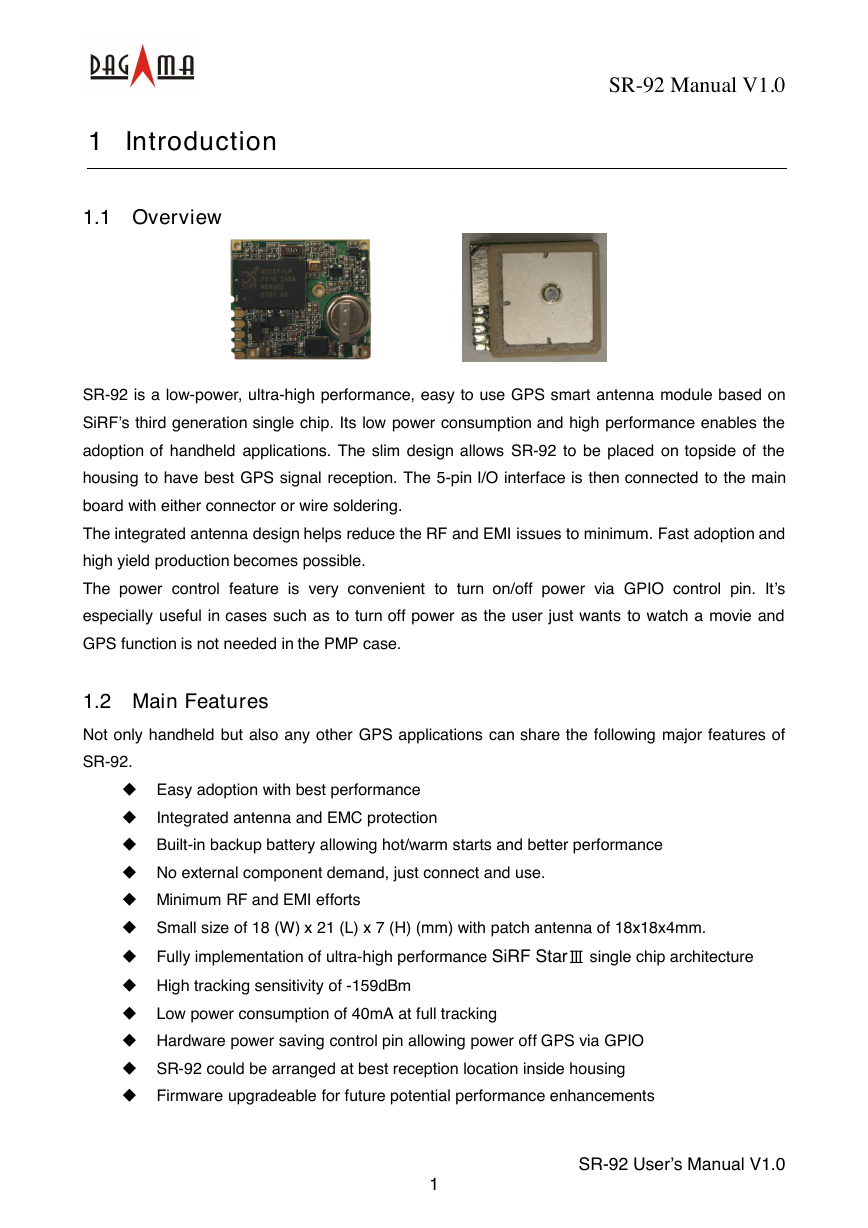
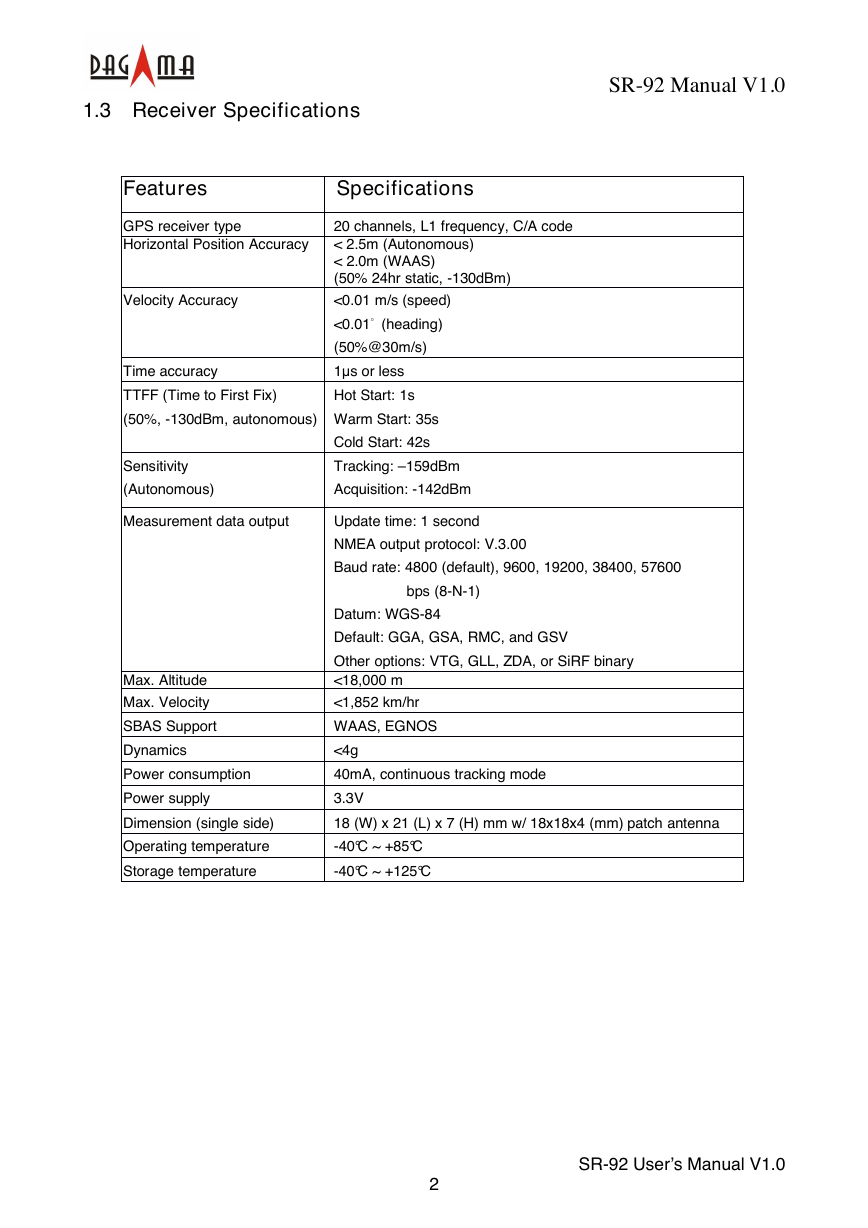
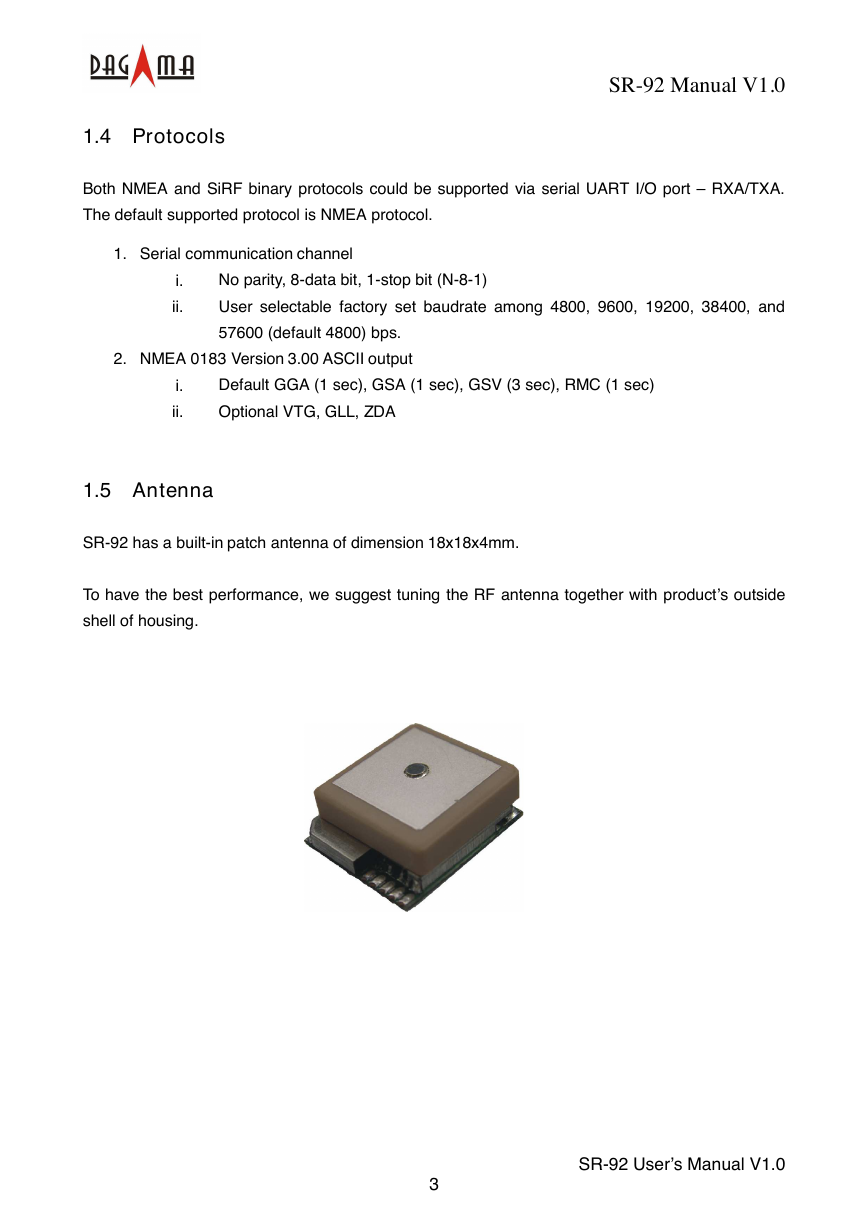
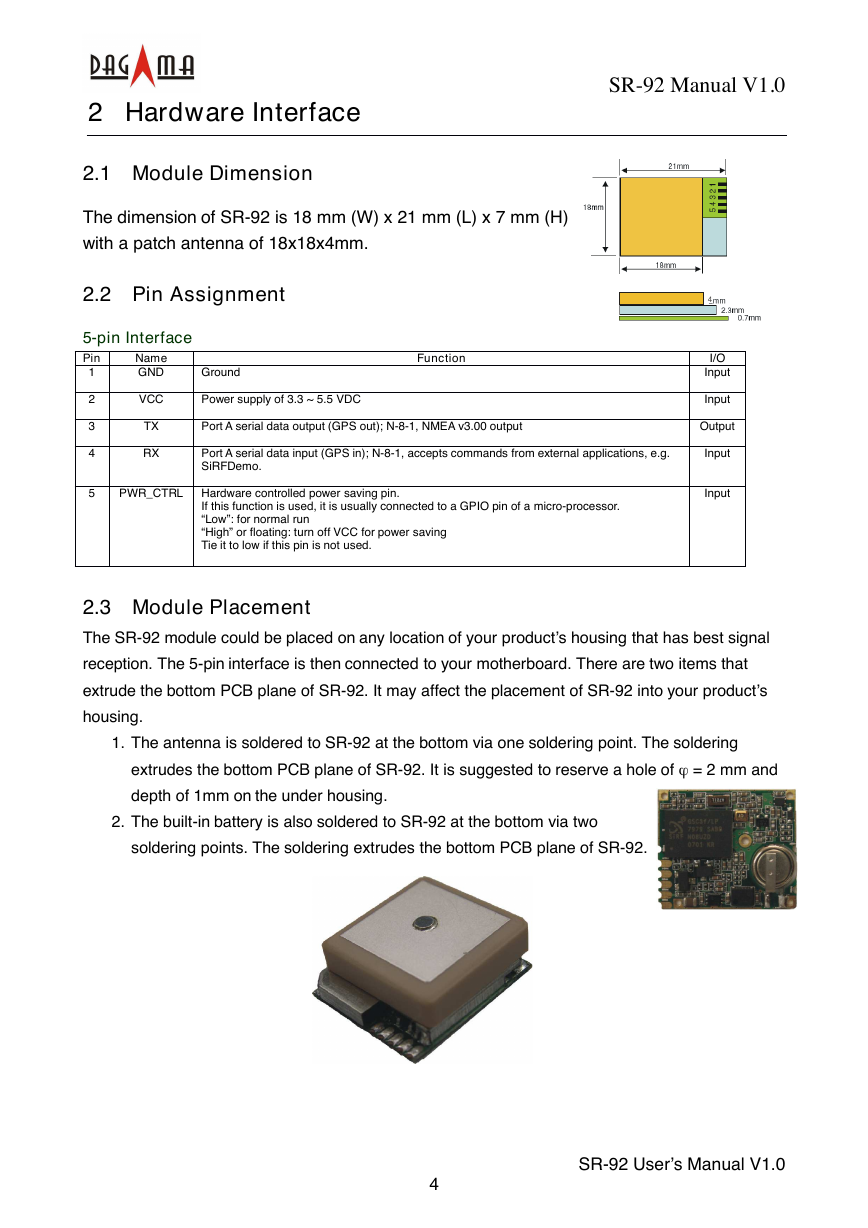

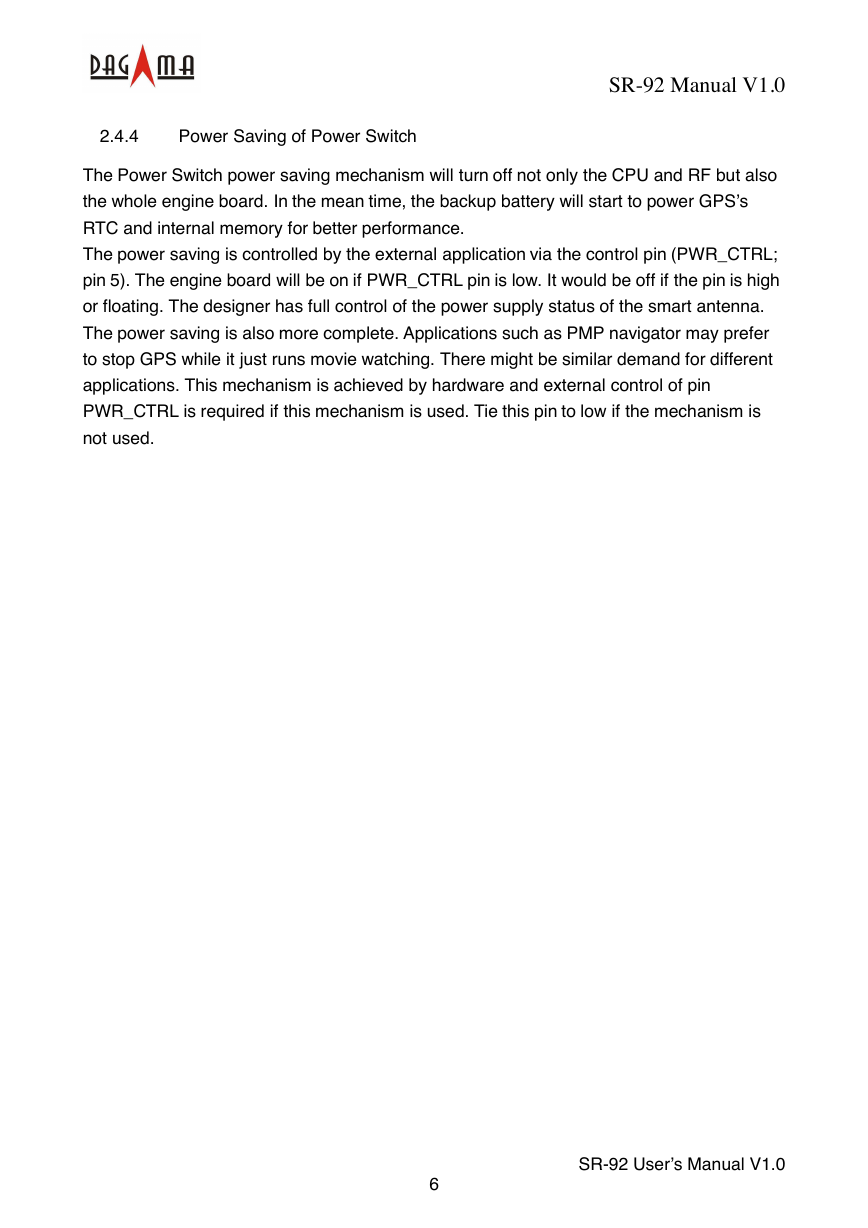








 2023年江西萍乡中考道德与法治真题及答案.doc
2023年江西萍乡中考道德与法治真题及答案.doc 2012年重庆南川中考生物真题及答案.doc
2012年重庆南川中考生物真题及答案.doc 2013年江西师范大学地理学综合及文艺理论基础考研真题.doc
2013年江西师范大学地理学综合及文艺理论基础考研真题.doc 2020年四川甘孜小升初语文真题及答案I卷.doc
2020年四川甘孜小升初语文真题及答案I卷.doc 2020年注册岩土工程师专业基础考试真题及答案.doc
2020年注册岩土工程师专业基础考试真题及答案.doc 2023-2024学年福建省厦门市九年级上学期数学月考试题及答案.doc
2023-2024学年福建省厦门市九年级上学期数学月考试题及答案.doc 2021-2022学年辽宁省沈阳市大东区九年级上学期语文期末试题及答案.doc
2021-2022学年辽宁省沈阳市大东区九年级上学期语文期末试题及答案.doc 2022-2023学年北京东城区初三第一学期物理期末试卷及答案.doc
2022-2023学年北京东城区初三第一学期物理期末试卷及答案.doc 2018上半年江西教师资格初中地理学科知识与教学能力真题及答案.doc
2018上半年江西教师资格初中地理学科知识与教学能力真题及答案.doc 2012年河北国家公务员申论考试真题及答案-省级.doc
2012年河北国家公务员申论考试真题及答案-省级.doc 2020-2021学年江苏省扬州市江都区邵樊片九年级上学期数学第一次质量检测试题及答案.doc
2020-2021学年江苏省扬州市江都区邵樊片九年级上学期数学第一次质量检测试题及答案.doc 2022下半年黑龙江教师资格证中学综合素质真题及答案.doc
2022下半年黑龙江教师资格证中学综合素质真题及答案.doc